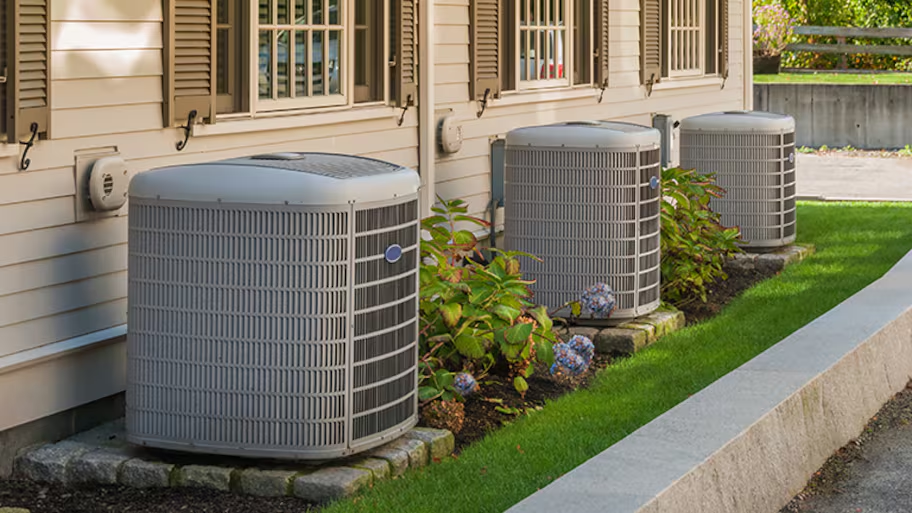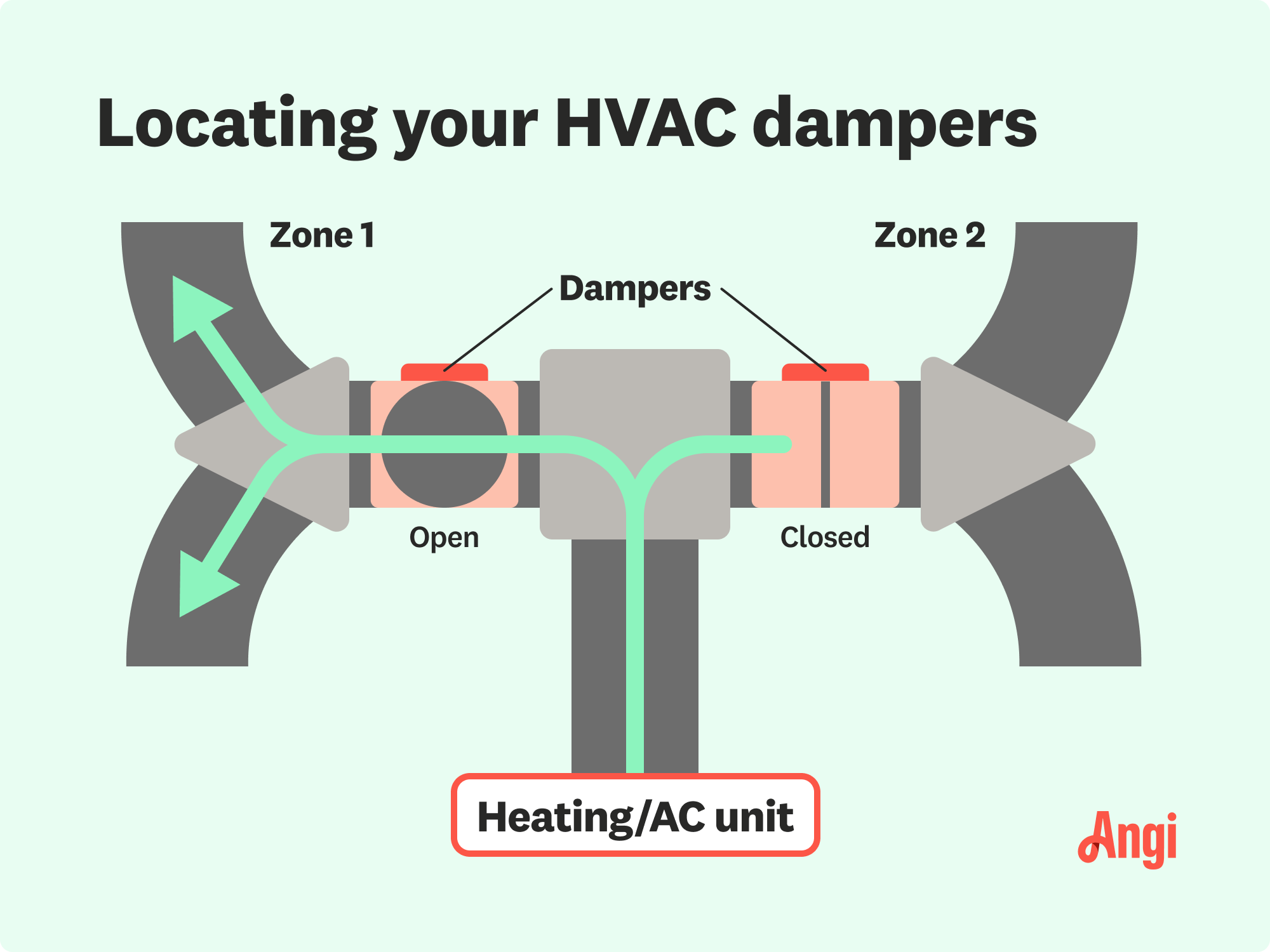
HVAC replacement costs depend on a lot of factors, like unit type, size, and labor. See what you can expect to pay for HVAC replacement here.
Duct dampers direct air downstream


Adjusting dampers in your ductwork can potentially save you money on your home’s heating and cooling bills. To change the damper's alignment, turn the damper’s lever 90 degrees. You can close dampers to cut off airflow to parts of your home, or you can open dampers to return the airflow to normal. Learning how to adjust dampers in ducts is easy once you find them. Let’s get started.
The most important preparation step for adjusting dampers in ducts in your home is to find the dampers. But what is a damper? A damper is a moveable plate inside the duct. You can adjust the alignment of the plate to cut off or allow airflow through the ducts beyond the damper.

Most homeowners will find HVAC dampers along the main trunk line of the HVAC system or within individual air duct runs. Look for levers or handles attached to the ductwork.
Places you can check for dampers include the following:
The main trunk line, which is the primary duct extending from your furnace that distributes air throughout your home.
The supply trunks that are a significant part of the duct that carries heated or cooled air into different rooms.
The air handler unit, typically located in a closet and connects to the HVAC trunk system.
It is important to note that not all homes have dampers, but when present, they help regulate airflow, boosting overall comfort.
You can adjust the dampers in your ductwork by following just a few steps. You would only follow these steps if you have manual dampers, though. If you have automatic dampers, they’ll close and open as needed to match your thermostat’s temperature settings with no intervention required on your part.

Start by turning on your thermostat's fan-only mode. Open all the registers on the supply grates in each room. The return air duct design means the return grates won’t have any way to open or close them, so they’ll continue pulling air in fan-only mode. Only the supply grates can be opened or closed.
Inspect the ductwork extending from your furnace or air handling unit. Look for a handle or lever on the outside of the ductwork to identify the location of the dampers. You may need a flashlight and step ladder to be able to find and reach the handles for the dampers.
Ideally, your dampers would have labels on them, designating which rooms they serve. Sometimes, looking for the labels first makes it easier to find the nearby handles.

Open all the dampers that you can find. Turn the handle until it’s parallel to the direction of the duct. This should be the open position. If the handle is perpendicular to the direction of the duct, this should be the closed position.
If you rarely or never move the dampers, the handles may be difficult to turn. You can use some pliers to help you move the handles into the desired position.
If your dampers have labels, figure out which ones you want to close. In winter, you may want to close dampers to the upper floors of the home. This allows the furnace to feed the lower floors efficiently. In summer, try closing the dampers to the lower floor or basement so cool air can more efficiently reach the upper floors of the home.
If they don’t have labels, you can use a trial-and-error process to determine which dampers control which rooms. You then can add labels.
Close a damper and use the direction of the ductwork down the line to try to figure out which rooms it serves. Go to the grates in those rooms and see if air is leaving the supply grates. If no air is coming out when you have the fan-only setting on, the closed damper serves this room. Continue with this process until you figure out the map of the ducts.

After you figure out how to adjust dampers in the ducts, create the desired setup. Let them run for a couple of days and monitor the overall system performance. If you’re unhappy with the airflow, make some changes to which dampers you have open and closed and observe the results for a couple more days. Continue with this process until you’re happy with the results.
Learning how to adjust dampers in ductwork is an easy DIY job. As long as you can climb a step ladder and don’t mind looking in dark areas (where some spiders may be lurking), you can turn the levers yourself.
However, you may want to call a professional if you don’t have a ladder or if you simply cannot find the dampers. Who does ductwork and damper inspections? A local duct installation company can help you find the dampers and adjust them. If you’re calling a pro to adjust the dampers, it’s also a good time to have an inspection of the ducts.
If you have dampers that close and shut automatically, but you don’t believe they are working or if you hear them banging, you should call a pro. Malfunctioning automatic dampers could be signs of bad ductwork.
Air duct inspection costs between $140 and $380, or $230 on average. The cost of an inspection mostly depends on the amount of ductwork you have in your home and the type of test performed. A visual inspection could cost as little as $80, while a more comprehensive smoke test with sampling for mold and bacteria can cost as much as $500.
Quality ductwork will increase the efficiency of your HVAC, sometimes by 20% to 30%. This is because there is reduced air leakage due to better insulation and more optimized airflow. This means your HVAC doesn't have to work as hard to keep the desired temperature, so it uses less energy.
From average costs to expert advice, get all the answers you need to get your job done.

HVAC replacement costs depend on a lot of factors, like unit type, size, and labor. See what you can expect to pay for HVAC replacement here.

Discover the true window AC unit installation cost to learn about labor, permits, and ways to save on your window AC project.

Heating and cooling system on the fritz? Discover the factors that go into HVAC repair costs and how you can save money on this crucial home update.

No one likes a cold shower or a frigid winter night. Regular boiler maintenance and repair will ensure your appliance stays in tip-top shape. Keep the hot water flowing year-round with these easy tips.

Do you have a clogged AC drain line? We dig into the reasons behind those pesky blockages and how to clear them for optimal AC performance.

Energy bills rising? Here’s how to perform a DIY duct leakage test to locate any damage in your ductwork and restore your energy-efficient home.